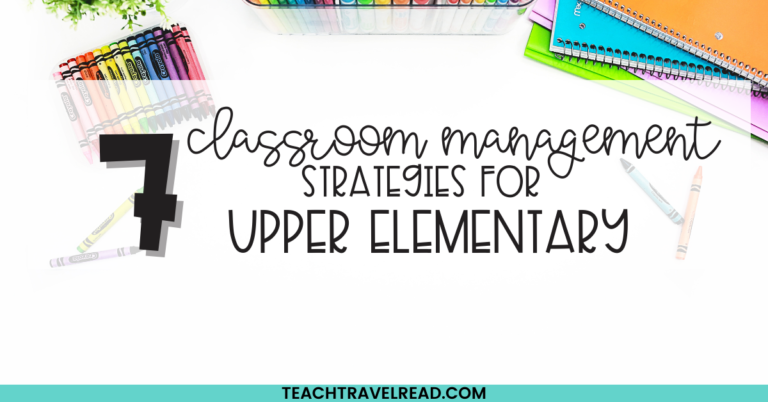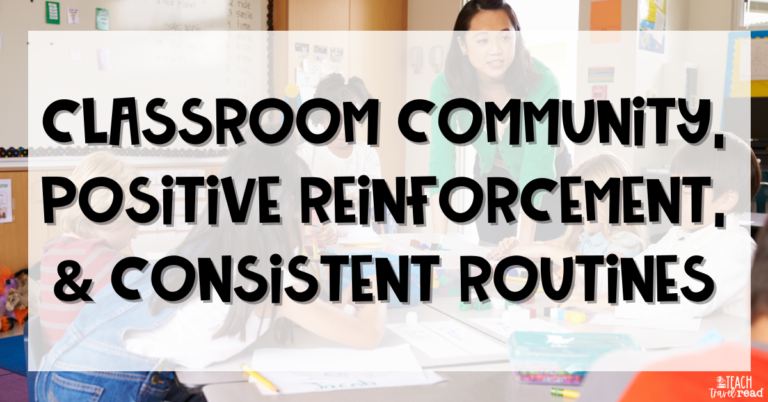
Successful classroom management begins on day 1 of the school year. With the beginning of a new school year just around the corner, it’s time to prepare ourselves and our classrooms for success. Effective classroom management is the start of a positive and productive learning environment. In the upper elementary grades, students are eager to explore, question, and grow. So, let’s dive into some friendly and practical classroom management strategies that will help us set the stage for a fantastic year!

Creating a positive classroom climate starts with setting clear expectations from day one. Engage your students in a collaborative discussion about what they believe makes a successful classroom. Ask students to share their thoughts related to classroom expectations.
Then, create visuals with the agreed-upon rules. Make sure these expectations are visible and displayed in the classroom. By involving them in the process, you empower them to take responsibility for their behavior.

Building a supportive and inclusive classroom community is essential for upper elementary students. Begin by incorporating icebreaker activities that allow students to get to know one another and form connections.
Create opportunities for cooperative learning and collaboration through group activities and discussions. Encourage open communication and active listening, emphasizing the importance of empathy and understanding.
Motivate and inspire your students by implementing a system of positive reinforcement. Recognize and celebrate their efforts, achievements, and positive behaviors. This can be as simple as offering verbal praise, providing stickers or tokens, or creating a class reward system. Celebrate milestones and achievements as a class, emphasizing the collective effort and the value of teamwork.
One of my favorite ways of using positive rewards is through the HOUSE system. Students are recognized on an individual level while earning points for their entire team. It helps promote that classroom community!
Upper elementary students thrive on structure and predictability. Establish consistent routines for daily tasks such as entering the classroom, transitioning between activities, and packing up at the end of the day.
Clearly communicate these routines and reinforce them until they become second nature. By maintaining a predictable environment, students feel secure and are better able to focus on their learning.
Engagement is key to effective classroom management. Gone are the days of the teacher standing at the front of the room lecturing. Design lessons that are hands-on, interactive, and tailored to the interests and abilities of your students.
Incorporate technology, visual aids, and real-world examples to make learning relevant and exciting. By captivating their attention, you reduce the likelihood of behavioral issues and promote a positive classroom atmosphere.
Take the time to get to know your students individually, their interests, strengths, and challenges. I like to set aside time to meet with students 1:1 which helps me learn more about them. Share about yourself, too. They want to know about your life and see what you have in common.
I send home a meet-the-teacher flier before the school year begins. Also, I have an All About Me presentation that I share with students on the first day. Then, I have the students create an All About Me slide that I use for our open house. Remember, when students feel seen, heard, and valued, they are more likely to engage positively in the classroom.
Maintaining open lines of communication with parents and guardians is essential for a successful classroom. Start the school year with an email or letter home to parents welcoming them to your classroom. Once the students begin the year, take time to make phone calls home (or send emails) to create a positive relationship.
Throughout the year, send home communication, such as newsletters, email updates, or a class website. Share information about classroom activities, upcoming events, and student progress. Invite parents to be actively involved in their child’s education, whether through volunteering, attending parent-teacher conferences, or participating in school events.
As we gear up for the beginning of the school year, remember that effective classroom management is an ongoing process. Be flexible and adaptable, continually assessing and adjusting your strategies to meet the unique needs of your students.
By setting clear expectations, building a classroom community, using positive reinforcement, maintaining consistent routines, incorporating engaging instructional practices, building positive relationships, and communicating with parents, you’ll create an environment where students can thrive academically and personally.
Love this journey for you!